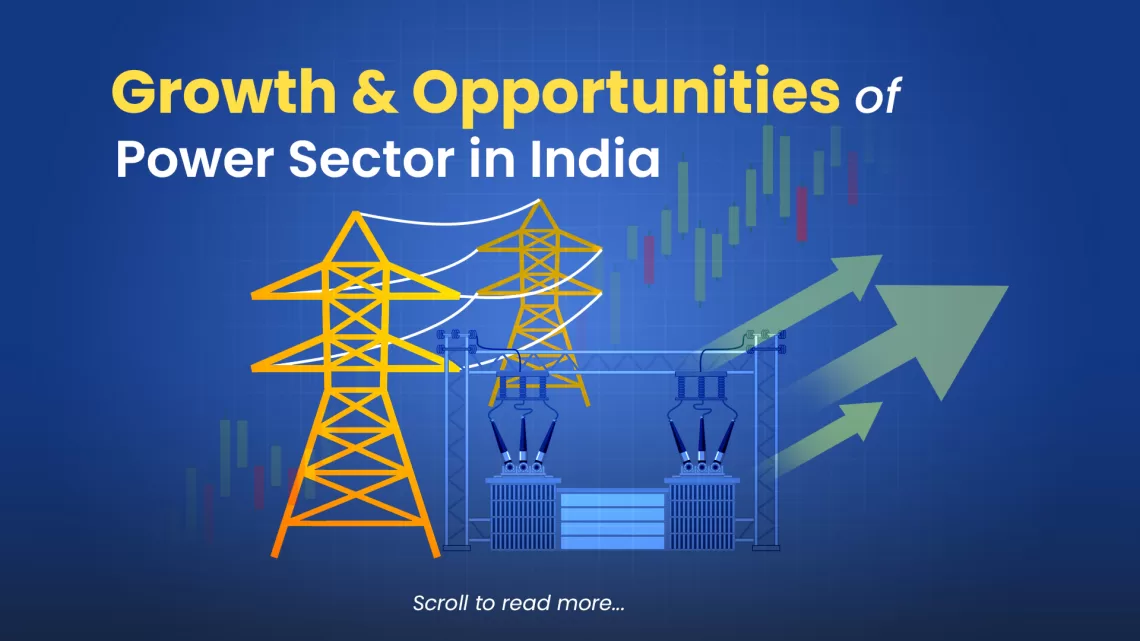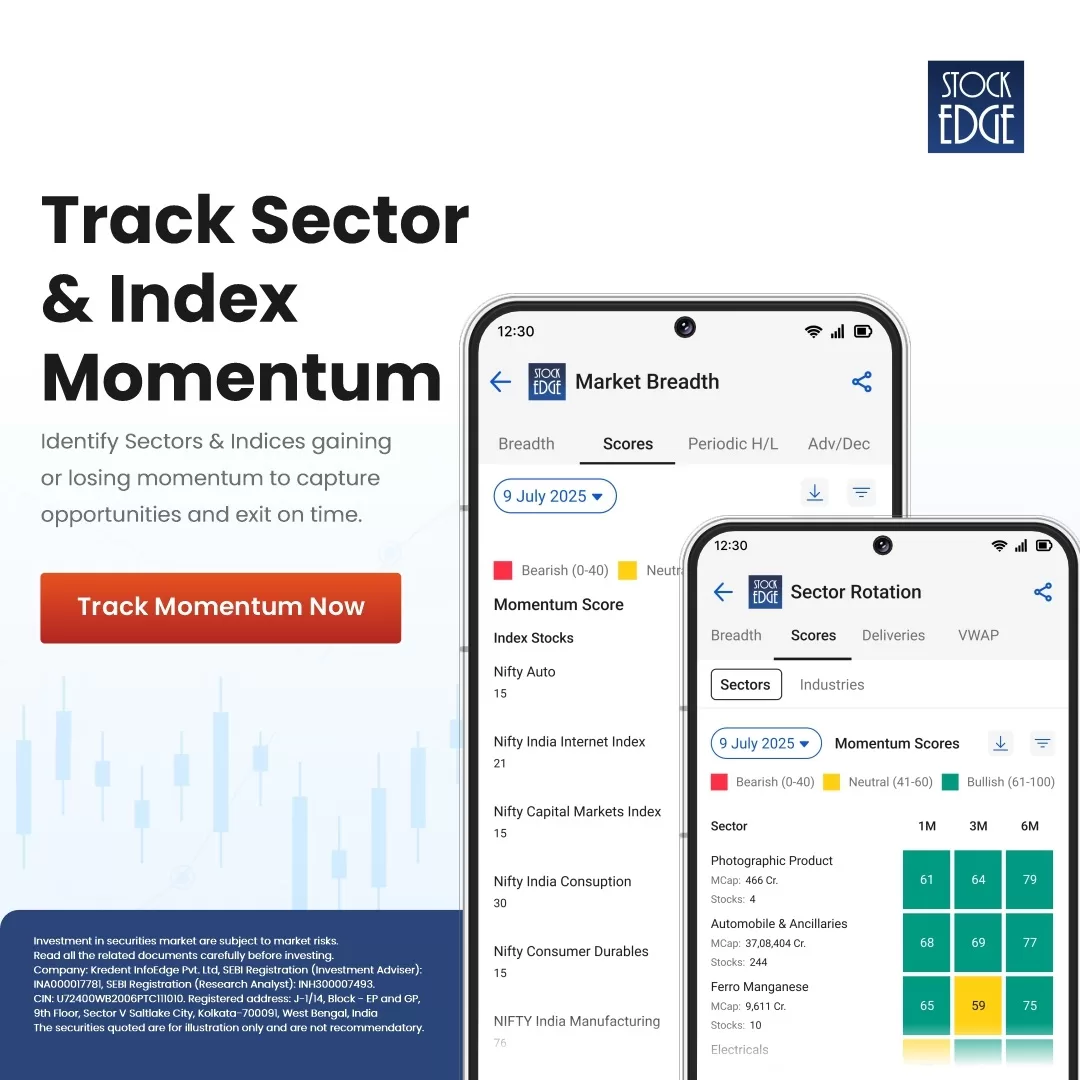Key Takeaways
- Expanding Capacity: India’s power sector is growing fast with rising demand, new capacity, and a strong clean energy push.
- Government Push: Schemes like PM Surya Ghar, RDSS, and Green Energy Corridor, plus 100% FDI, boost infrastructure and renewables.
- Clean Energy Focus: In 2024, 83% of investments went to renewables, with solar, wind, and hydro gaining pace alongside coal for energy security.
- Top Players: NTPC, Power Grid, and Tata Power are expanding, focusing on green energy and big investment plans.
- Opportunities & Risks: Growth is high but challenges remain—AT&C losses, stressed DISCOMs, delayed payments, and policy uncertainty.
Table of Contents
From lighting up rural homes to fuelling industrial ambitions, electricity is the invisible force behind India’s transformation into a $5 trillion economy. But behind every glowing bulb and humming factory lies a vast, complex power sector, one that’s undergoing a historic shift.
In this blog, we’ll break down the structure of the power sector in India, explore the forces driving its growth, recent policy reforms, the green energy transition, foreign investment trends, and the risks investors and top power sector players need to watch.
Structure of Power Sector in India
The power sector in India is not just a linear system but a complex value chain that involves the conversion of raw energy into usable electricity, delivered to end consumers across urban and rural India. A value chain analysis breaks down the entire ecosystem into key activities, helping stakeholders identify strengths, inefficiencies, and opportunities for innovation or investment.
Here’s a detailed breakdown of the value chain of the power sector in India:
1. Energy Resource Management
This is the foundation of the power sector in India. It includes the sourcing and transportation of fuels or energy inputs necessary for power generation. It contains thermal energy such as (coal, natural gas, and diesel), renewable sources (solar & wind), hydro energy, and nuclear fuel.
2. Power Generation
The generation stage involves converting energy sources into electricity. This is done at thermal power plants (coal, gas), hydroelectric plants, nuclear reactors, or renewable energy facilities such as solar and wind farms. Both public and private entities are active in this segment. Public sector companies like NTPC, NHPC, and NPCIL operate large-scale plants, while private companies like Adani Power, Tata Power, and ReNew Power have a significant presence in renewable and thermal generation.

3. Transmission
Once electricity is generated, it needs to be transported over long distances to reach consumption centres. This is the role of the transmission segment. It involves high-voltage transmission lines, substations, and grid infrastructure. This segment in the power sector in India is led by Power Grid Corporation of India (PGCIL), which manages the interstate transmission and the national grid.
4. Distribution
Distribution is the final physical delivery stage of the value chain. Electricity is stepped down from high voltage to medium and low voltages and distributed to residential, commercial, agricultural, and industrial consumers. State-owned distribution companies (DISCOMs) dominate this segment, although private firms operate in some cities. This is a critical link in the power sector in India, affecting revenue recovery and consumer satisfaction.
5. Trading and Market Operations
Electricity trading allows surplus power to be bought and sold across different regions and entities, ensuring efficient allocation of resources. This segment includes short-term, day-ahead, and real-time markets. Platforms like the Indian Energy Exchange (IEX) and Power Exchange India Ltd (PXIL) facilitate such transactions.
6. Policy & Regulation
Although not a physical stage, regulatory oversight is a critical enabling layer of the value chain. Central and state regulatory bodies govern tariff structures, grid standards, licensing, and compliance. The Ministry of Power sets overall policy direction, while the Central Electricity Regulatory Commission (CERC) and State Electricity Regulatory Commissions (SERCs) frame and implement regulations.
7. End Consumer
The end consumer is the ultimate recipient of electricity and the reason the entire value chain exists. Consumers are broadly categorized into four segments:
- Residential: Households and individual users
- Commercial: Offices, retail stores, and service sector establishments
- Industrial: Large and small manufacturing units
- Agricultural: Farmers and rural pump sets
Consumers receive power through the distribution network and are subject to tariff structures regulated by State Electricity Regulatory Commissions (SERCs). Their usage patterns, payment behaviors, and demand profiles significantly influence planning across all other stages of the value chain.
What’s Driving the Growth of the Power Sector in India?
Let’s check out the growth of the power sector in India
Rising Electricity Demand
India has experienced the third-largest growth in power generation capacity globally over the past five years, after China and the United States. This surge in demand is fueled by increased commercial and residential spaces, a rise in air conditioner and appliance ownership, and growing industrial demand.
Dominance of Clean Energy Investment
In 2024, 83% of India’s power sector investment went to clean energy. This marks a substantial increase, with renewables investment growing by 17% to USD 33 billion in 2024 and projected to climb a further 12% in 2025.
Continued Coal Investment
Despite the surge in renewables, India, alongside China, is also witnessing a significant rise in approvals for new coal-fired generation. This is driven by rapidly increasing electricity demand and concerns about electricity security. New coal capacity is expected to service incremental demand not met by renewables and to provide round-the-clock firming solutions to support renewables, mirroring trends in China. The increase in coal investment to a record level in 2025 is led by China and India to meet domestic demand.
Government Policies and Initiatives
India has introduced multiple initiatives to enhance power generation and its infrastructure, such as the PM Surya Ghar: Muft Bijli Yojana for rooftop solar, the Revamped Distribution Sector Scheme (RDSS) to strengthen distribution networks, and the Green Energy Corridor project for renewable energy transmission. The nation also targets reaching 500 GW of non-fossil fuel capacity by 2030, backed by policies like the Production-Linked Incentive (PLI) Scheme for solar module manufacturing.
Financing and Investment Sources
India was the world’s largest recipient of Development Finance Institution (DFI) funding in 2024, receiving approximately USD 2.4 billion for clean energy generation projects. While domestic sources meet a large share of investment, foreign direct investment (FDI) in the electricity sector has been steadily growing, reaching USD 5 billion in 2023, nearly double pre-pandemic levels. This is facilitated by policies permitting 100% FDI across most electricity generation sources and transmission infrastructure.
Risks and Challenges
India’s power sector, while expanding rapidly, is burdened with several deep-rooted challenges that limit its efficiency, profitability, and long-term sustainability. Now, let’s check out these challenges:
High AT&C Losses (Aggregate Technical & Commercial)
One of the key challenges is high Aggregate Technical and Commercial (AT&C) losses. These losses arise from inefficient power transmission, theft, and unbilled consumption. Outdated infrastructure and weak enforcement in billing and collection processes make it difficult for power distribution companies (discoms) to recover costs, leading to significant revenue losses. According to PFC, AT&C losses during the year grew from 15.3% to 16.3%, driven by a 1.2% point decrease in collection efficiency.

Financial Stress in Distribution Companies (DISCOMs)
Many state-run discoms operate under financial distress due to a mix of subsidized tariffs, free electricity schemes, and operational inefficiencies. Political pressure to keep electricity prices artificially low prevents regular tariff hikes, forcing discoms into debt and delaying payments to power generators. The accumulated losses of power distribution companies (DISCOMs) in India have reached critically high levels, placing significant financial strain on both the sector and state governments. As of FY2024, the accumulated deficit of DISCOMs across the country grew to ₹6.92 lakh crore, up from around ₹6.46 lakh crore in FY2023, showing a 7% increase.

Delayed Payments to Generators
Another key concern is the slow payment cycles to power generators. Discoms frequently delay payments for 60–120 days or more, especially affecting renewable energy producers, who rely heavily on prompt cash flows. This causes liquidity problems and weakens confidence in the sector’s financial stability. However, Days Receivable improved to 115 days in FY24 from 118 days in FY23.

Geopolitical & Regulatory Uncertainty
Geopolitical events, such as conflicts or trade tensions, can disrupt power supply chains and fuel prices, highlighting our dependence on imports, especially in Europe and the UK. Additionally, frequent policy changes, inconsistent enforcement across regions, and delays in approving tariff updates can create significant uncertainty for investors and power companies. These regulatory challenges can make long-term investments, particularly in capital-heavy areas like transmission and renewables, seem daunting and less attractive.
Top 3 Power Sector Companies
NTPC
NTPC Limited is India’s largest integrated power utility with a diversified portfolio including thermal, hydro, solar, wind, and nuclear power. As of FY25, NTPC Group’s installed capacity stands at approximately 79,930 MW, with the standalone capacity being 59,413 MW. The company reported a consolidated revenue from operations of ₹49,834 crore for Q4 FY25, up 4.6% year-over-year, and a net profit of ₹7,897 crore, a 21.7% increase compared to Q4 last year. For FY2025, consolidated revenue reached ₹1,88,138 crore (up 5.4% YoY), and net profit was ₹23,953 crore (up 12.3% YoY).
Why Does It Stand Out?
Looking ahead, NTPC plans significant capacity additions totaling about 11,800 MW in FY26, split among thermal (3,580 MW), hydro (1,000 MW), and renewable energy (7,226 MW). Capital expenditure is expected to rise, with ₹87,661 crore forecasted for standalone capex over FY26-FY28 and ₹265,455 crore for the group overall. The company is also developing pumped storage projects and expanding captive coal production to support operational needs. To know more about its future prospects, read our edge report.
Power Grid
Power Grid Corporation of India Limited (POWERGRID), India’s central transmission utility and a “Maharatna” company, reported for Q4 FY25 a consolidated net profit (PAT) of ₹4,143 crore, slightly down 0.6% year-over-year from ₹4,166 crore in Q4 FY24. Revenue from operations for the quarter was ₹12,591 crore, up 2.3% YoY. It posted a consolidated PAT of ₹15,521 crore in FY25, almost flat compared to ₹15,573 crore in FY24, with total income slightly increasing to ₹47,459 crore from ₹46,913 crore the previous year.
Why Does It Stand Out?
Power Grid Corporation of India has a robust future outlook with ambitious capital expenditure plans to support its growth. The company plans a capex of ₹28,000 crore in FY26, which is expected to commission projects worth ₹22,000 crore. This capex is set to increase to ₹35,000 crore in FY27 and ₹45,000 crore in FY28, reflecting strong expansion in infrastructure investment. To know more about its future prospects, read our edge report.
Tata Power
Tata Power Company Limited, India’s largest integrated power company, has a presence across the power value chain through the generation of renewable as well as conventional power (including hydro and thermal energy), transmission & distribution and trading. As on 31st March 2025, the company had 73 subsidiaries (of which 21 are wholly-owned), 16 joint ventures (JVs) and 6 associates. It has a generation capacity of 15,733 MW based on various fuel sources. Of the total installed capacity, the company (including its subsidiaries) has 56% from thermal generation sources and 44% of its capacity (in MW terms) in clean and green generation sources (hydro, wind, solar and waste heat recovery).
Why Does It Stand Out?
The management plans to limit its exposure to coal-based projects and does not intend to expand its existing portfolio. It is consistently building on its innovative initiatives to reduce GHG emissions and improve operational efficiency to reduce energy consumption. They plan to attain carbon neutrality before 2050. To know more about the future outlook, read our edge report.
Future Outlook in the Indian Power Sector
India is on track to reach its 2030 target of 50% non-fossil generation capacity ahead of schedule. In 2024, the share of non-fossil power generation capacity reached 44%. To stay on track for its net-zero by 2070 ambition, India will cumulatively need to invest USD 1.3 trillion in non-fossil power generation capacity by 2035. Under the Announced Pledges Scenario (APS), India’s clean energy investment growth almost triples by 2035.

Frequently Asked Questions (FAQs)
Which is the largest company in India’s power sector?
NTPC, India’s leading power generation company, operates 92 power units across multiple states, either independently or via joint ventures and subsidiaries. With an installed capacity of 76 GW, it recorded its highest profit and output in FY24, generating ₹1.57 lakh crore in revenue.
What is the market size of the power sector in India?
India’s power sector is among the most diversified in the world, with generation from conventional sources like coal, gas, hydro, and nuclear, as well as renewable sources such as solar, wind, biomass, and small hydro. According to the PIB (Press Information Bureau), as of June 2025, India’s total installed power capacity has reached a significant milestone with 476 GW, led by 240 GW of thermal, 110.9 GW of solar, and 51.3 GW of wind power, marking a strong shift towards renewable energy and energy security.











